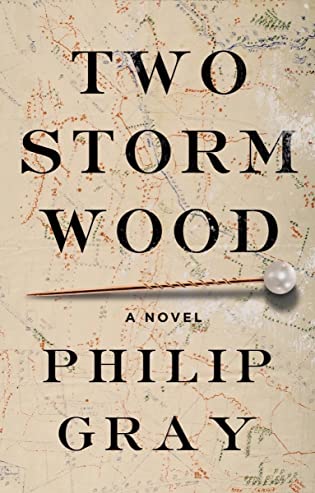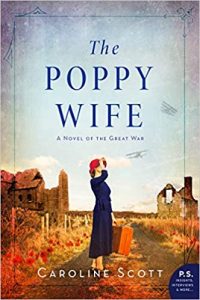 Two Storm Wood by Philip Gray
Two Storm Wood by Philip Gray Format: eARC
Source: supplied by publisher via Edelweiss
Formats available: hardcover, ebook, audiobook
Genres: historical fiction, historical mystery, thriller
Pages: 352
Published by W. W. Norton & Company on March 29, 2022
Purchasing Info: Author's Website, Publisher's Website, Amazon, Barnes & Noble, Kobo, Bookshop.org, Better World Books
Goodreads
In this thriller set on the battlefields of the Somme after the end of World War I, a woman investigates the disappearance of her fiancé.
The Great War has ended, but for Amy Vanneck there is no peace. Her fiancé, Edward Haslam, a lieutenant in the 7th Manchesters, is missing, presumed dead. Amy travels to the desolate battlefields of northern France to learn his fate and recover his body.
She’s warned that this open-air morgue is no place for a civilian, much less a woman, but Amy is willing to brave the barbed wire, the putrid water, and the rat-infested tunnels that dot the landscape. Her search is upended when she discovers the scene of a gruesome mass murder. What does it signify? Soon Amy begins to have suspicions that Edward might not really be dead. Disquieting and yet compulsively readable, Two Storm Wood builds to an ending that is both thrilling and emotionally riveting.
My Review:
“The evil that men do lives after them; The good is oft interred with their bones.” Honestly, Shakespeare pretty much said everything best. This particular quote is from Julius Caesar, but it’s relevant to Two Storm Wood because the mystery in this historical thriller revolves around an attempt to attach the evil that one man did to another man’s bones – even if the man’s actual bones can never be found.
The story begins with a mystery. Two soldiers in a convalescent hospital for men with facial disfigurements back home in England after the Armistice that ended World War I. One kills the other, after stealing the victim’s uniform and identity papers. The reader knows nothing about them, not their names, not their real identities. Only that they are officers and that one is impersonating the other – whoever either or both might be.
Then the focus shifts to Amy Vanneck, whose name we definitely DO know, as she escapes from the smothering confines of her status conscious, social climbing, upper middle class family to sneak away to France with a friend. The war may be over for many, but not for Amy or the tens of thousands of others whose loved ones were listed as “missing, presumed dead.”
So Amy heads for France, to the former battlefields of the Great War, now turned into vast, disturbed – and disturbing – fields of unmarked graves, filled with bodies that may never be identified. She’s certain that her fiancée is one of those bodies, and that the responsibility for his fate can be laid at her door – whether she knew it or not.
She’s also promised him she’d find him after the war, and bring him home. Even if all she has to bring back is a corpse. But the more she digs into his fate, the less certain she is – not just about what happened to him, but about who the man she loved really was.
Or who he became in that hellscape of war.
Her search takes her from one mass grave to another, from one putrid processing station for the dead to the few and frequently shell-shocked men who served with Lieutenant Edward Haslam, teacher, choirmaster, officer, and as she discovers along her hellish journey, assassin.
There are two things she does not find. She does not find his body. And she does not find the truth – a truth which seems to be drifting further out of reach the longer and further she searches.
Along with evidence that someone is dogging her trail, determined to stop her from finding anything or anyone at all.
Escape Rating B+: I picked this up expecting it to remind me of Charles Todd’s historical mysteries. With its focus on Amy Vanneck as the protagonist, I thought I’d be catching glimpses of nurse Bess Crawford, but as the story progressed I got just as many hints of Todd’s other investigator, Inspector Ian Rutledge of Scotland Yard.
Little did I know that I had just swallowed a red herring.
 More than either of those series, the book that Two Storm Wood resembled the most strongly was The Poppy Wife by Caroline Scott, which also focuses on the search for closure after World War I for so many whose loved ones were declared missing during the war. In some ways, Two Storm Wood is even more haunting that The Poppy Wife, as Amy’s search takes place much closer to the Armistice, when the situation was in even more flux as the ground was still literally settling over the shallowly buried dead.
More than either of those series, the book that Two Storm Wood resembled the most strongly was The Poppy Wife by Caroline Scott, which also focuses on the search for closure after World War I for so many whose loved ones were declared missing during the war. In some ways, Two Storm Wood is even more haunting that The Poppy Wife, as Amy’s search takes place much closer to the Armistice, when the situation was in even more flux as the ground was still literally settling over the shallowly buried dead.
Amy goes to France expecting to find closure. She honestly hopes to find and identify her fiancée’s corpse. Instead, she finds a place where no one expects her – or any other “gently bred” woman to be as she travels alone through a world that belongs more to the dead than to the living. She’s in way over her head with no idea how impossible the task she has set herself truly is.
But she is also free, free from social expectations, free from her mother’s social climbing snobbery, and free to learn just how strong a person she can be when she has no one to rely on but herself. She doesn’t thrive, because no one in these circumstances is even in the same country as “thriving”, but she does persevere.
Even as two men who both claim to be working for the Graves Commission try to dissuade her or redirect her from her self-appointed course. Yet both their involvement and Amy’s own investigations lead her inexorably to Two Storm Wood, and to a crime so heinous that the Army has already begun covering it up.
Whatever and however many other books Two Storm Wood reminded me of, at its center it felt like three stories. One is the story of Amy’s journey through the haunted battlefields, mass graveyards and half-ruined towns and villages that haven’t even begun to recover from the war. It’s not just that war is hell, but that its aftermath is every bit as hellish as the actual fighting – if not worse because it’s supposed to be over but it really isn’t.
The second story was Amy’s search for who Edward Haslam really was, and who he became in that no man’s land of trenches and raids and death on every side. We see the beginning of their relationship through Amy’s memories, and their wartime separation through the letters that Edward sent. The most chilling bit of this part of the story is the way that the more she learns, the less she feels she knows – as though everything she thought was true is slipping away from her.
The third part of the story was the mystery of what really happened at Two Storm Wood. In the end, the actions themselves become clear, but the motives behind them didn’t feel like they were as interwoven with the rest of the story as they should have been for a reveal that turned out to be so fundamental. That bit felt kind of tacked on to a story that had been both chilling and affecting as it followed Amy’s journey. They did tie together at the end, but that tie didn’t feel as tight as it should have been.
But Amy’s journey is a compelling and heartrending read about the way that the horrors of war are inflicted not just on those who fight but on those who are left behind. And that the scars war leaves behind are just as deep on all sides.
One final note, the Graves Commission whose work Amy follows in this story is not yet done. It’s successor organization, the Commonwealth War Graves Commission, is still finding and identifying the dead of the First World War at the rate of one per week more than a century after the Armistice.
